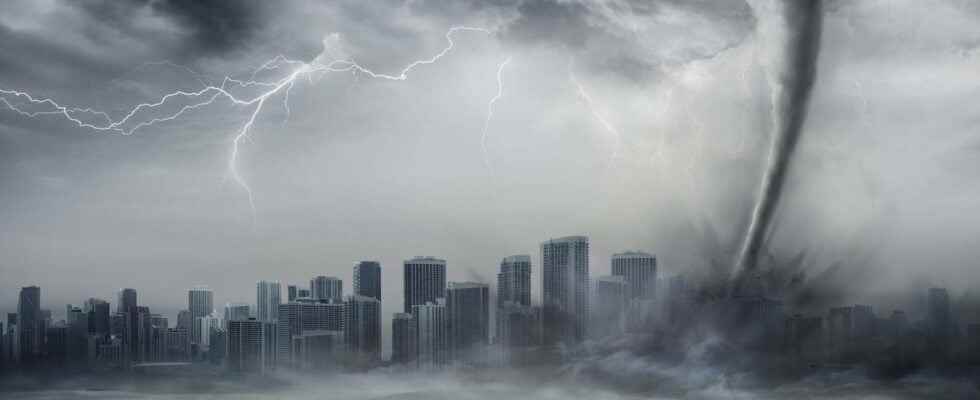Hurricanes and tornadoes are the most destructive wind phenomena on the planet. Although they can occur in the same place, and sometimes at the same time, they are two separate phenomena. How to differentiate them?
You will also be interested
[EN VIDÉO] A powerful tornado recreated by computer Concerned by the hundreds of tornadoes that plague the central United States each year, researchers there are trying to better understand how these devastating monsters form. Scientists have reconstructed with a supercomputer the “El Reno” tornado, one of the most powerful ever observed, which hit Oklahoma on May 24, 2011. It destroyed everything in its path over more than 100 km for nearly two hours… Thanks With this simulation, we better identify the phenomena at work.
Winds over 200 km/h, catastrophic damage over long distances, and often casualties: the terms ofhurricanes and tornadoes are sometimes confused by the general public when it comes to talking about phenomena related to high winds.
Tornadoes, an ultra-violent whirlwind on earth
Tornadoes are the most violent wind systems in the world, with winds that can exceed 300 km/h. A tornado necessarily forms under a thunderstorm : this little whirlwind terrestrial is a column ofair, rotating, extending from the base of a cloud ofthunderstorm down to the ground. The whirlwind must come into contact with the ground for it to be called a tornado. If this tornado forms under a thunderstorm at sea, then it is a waterspout. For a tornado to form, there must first be a thunderstorm which develops when humid air meets cold air: the meeting of the two creates a great instability of theatmosphere which generates powerful storms, supercells. The most violent tornadoes form under supercell thunderstorms, especially in the United States, the country most affected by tornadoes.
A tornado is a small phenomenon compared to hurricanes, it is a very localized event. The tornado extends from a few meters to four kilometers for the widest recorded, but it can move a few hundred meters for a few seconds or even tens of kilometers for several hours. Tornado intensity is classified with the Enhanced Fujita Scale (EF for Enhanced Fujita, in English), from EF0 (winds swirling up to 130 km/h) to EF5 (more than 322 km/h).
Formation of a tornado under a supercell thunderstorm in Kansas, United States, in 2016. © Negative Tilt
Hurricanes, a tropical phenomenon that forms at sea
The hurricane forms in the ocean, it is a very vast phenomenon which extends over 300 to more than 800 kilometers, and can cover a very great distance. On the other hand, it runs out quickly as soon as it hits the ribs. The hurricane generates torrential downpours and powerful winds: the greatest danger from hurricanes for the human population is the rains and the rise in sea level, much more than the winds. Intense rains often result in floods, and are long-lasting (several days), whereas the violent winds are concentrated mainly on the coasts, and very little reach the land.
The hurricane is part of what are called the cyclone phenomena : its formation begins with an area of instability that forms above tropical and subtropical waters. The heat of the ocean is a necessary ingredient for the formation of a cyclonic phenomenon, it is the main fuel that feeds its energy. This usually requires a temperature of at least 27°C in the water, but the warmer the water, the greater the risk of cyclonic phenomena. The tropical depression is the first stage of formation, the phenomenon is then reinforced in tropical storm and eventually into a cyclone, called a hurricane in the North Atlantic. He then takes a movement of circular rotation. The intensity of the hurricane is classified on theSaffir-Simpson scale, from category 1 (from 119 to 153 km/h) to category 5 (more than 251 km/h).
While there are about ten hurricanes a year in the North Atlantic, more than 1,000 tornadoes occur each year in the United States (and 20 to 50 on average in France). Most tornadoes occur during the season tornadoes and thunderstorms, from February to June in the United States, while hurricanes form during the Atlantic hurricane season from June to November.
Even if the phenomena of hurricane and tornado are quite distinct, there is a link between the two: the instability of the hurricane generates storms around it, and therefore sometimes tornadoes under these storms. These tornadoes do not necessarily occur under the hurricane, but usually a few days to a few hours before the hurricane makes landfall.
Arrival of Hurricane Laura on the south coast of the United States, in August 2020: we can clearly see the bright flashes of the storms around the winding. © NOAA
Interested in what you just read?
